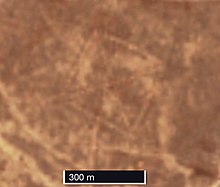
The Steppe Geoglyphs are a number of earth constructions in the Turgai Trough area of Turgai in northern Kazakhstan. There are at least 260 of these earthworks.[1][2]
The constructions
[edit]Many or all of them consist of smaller earthworks (mounds, trenches, and ramparts) arranged with each other to make geometric and other shapes (composite figures). These shapes are squares, rings, and three others.[1] The composite figures range from slightly under 90 m in length to over 400 m in diameter.[3] Besides being made of earth dug out and piled up, some of the geoglyphs are made by placing stones next to each other.[citation needed]
Some of the large shapes have been given names, including Bestamskoe Ring, Ushtogaysky (or Ushtogay) Square, Turgay triradial swastika,[4] Large cross Ashtasti, Ekedyn cross, Ashutasti ring, Kyzyloba line, Koga cross, and Shili square.[1][5]
These shapes are large enough to be easily visible on Google Earth. The Ushtogay Square is at 50°49′59″N 65°19′35″E / 50.832933°N 65.326276°E. The Turgay triradial is at 50°06′10″N 65°21′39″E / 50.102778°N 65.360833°E, only about 800 metres (1⁄2 mi) from the town of Urpek. Both are inside Amangeldi District, Kostanay Region.
Discovery and suggested origins
[edit]The earthworks were discovered in 2007 by Dimitriy Dey.[6][7] He found them by searching Google Earth's satellite images for pyramids and similar configurations in Kazakhstan.[6] They were first reported to the scientific community in 2014.[8]
Optical dating (optically stimulated luminescence) has been used to determine that one of the mounds dates to around 8000 B.C.E.[1][9]
References
[edit]- ^ a b c d Blumenthal, Ralph (October 30, 2015). "NASA Adds to Evidence of Mysterious Ancient Earthworks". Retrieved November 1, 2015.
- ^ Epstein, Adam (October 31, 2015). "Even NASA is perplexed by these otherworldly 8,000-year-old formations in Kazakhstan". Retrieved November 1, 2015.
Since then, Dey has found about 260 of the land designs—which resemble crop circles, but are much stranger.
- ^ Nalewicki, Jennifer (April 20, 2017). "Where to See Five of the Planet's Most Mysterious Geoglyphs". Smithsonian Magazine. Smithsonian. Retrieved 23 May 2022.
- ^ Jarus, Owen (September 23, 2014). "Nazca Lines of Kazakhstan: More Than 50 Geoglyphs Discovered". Live Science. Retrieved November 1, 2015.
More than 50 geoglyphs with various shapes and sizes, including a massive swastika, have been discovered across northern Kazakhstan in Central Asia, say archaeologists.
- ^ "Geoglyph Turgay Trough". turgay.kz. University of Pittsburgh. September 2015. Retrieved 9 November 2015.
- ^ a b Blumnethal, Ralph (October 30, 2015). "NASA Adds to Evidence of Mysterious Ancient Earthworks". Retrieved November 1, 2015.
Spotted on Google Earth in 2007 by a Kazakh economist and archaeology enthusiast, Dmitriy Dey, the so-called Steppe Geoglyphs remain deeply puzzling and largely unknown to the outside world.
- ^ Jarus, Owen (September 23, 2014). "Nazca Lines of Kazakhstan: More Than 50 Geoglyphs Discovered". Live Science. Retrieved November 1, 2015.
Discovered using Google Earth, the geoglyphs are designed...
- ^ Shevnina, Irina (1970-01-01). "Steppe Geoglyphs mark the ancient routes of human migration across Central Asia introduction to the research | Irina Shevnina". Academia.edu. Retrieved 2016-02-16.
- ^ [1] [dead link]
External links
[edit]- Turgay Discovery Research project
- NASA photographs from space
- Kazakhstan Earthworks KML placemarks file for Google Earth.
- 50°06′06″N 65°22′14″E / 50.101705°N 65.370420°E. Turgay triradial swastika